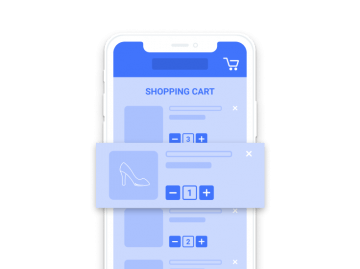Features of mobile applications that affect loyalty building.
One of the factors most often having impact on a company’s success is its ability to keep existing clients, from building relationships with them and consequently strengthen them. Among the most effective methods of building loyalty is engaging users via a mobile app. It’s connected with how the medium is consumed and its characteristics, among which there are:
- personalization of communication – much greater than with other channels (chiefly considering the quality of information gathered)
- continuity and immediacy of contact – supported additionally by contextuality which enables full adjustment of the message to the circumstances the user is in
- comfort of use – much bigger than on a mobile web version, if only because of shorter loading time
- greater functionality – including also functions not available on the mobile web version (e.g. push notifications with personalized offers)
If users download our app, they do it for example because they want to keep in touch with us. Providing their data, they expect personalization and benefits: constant communication, updates on news and changes, a customized offer, discounts, deals, etc. Building loyalty and strengthening the engagement consists in a large part in providing all of it to them, however, loyalty to the brand should be concerned in a much broader context.
Below, we’re presenting an overview of the most common methods of building loyalty with mobile apps.
Loyalty strengthening mechanisms
1. Reward activity
Rewarding user activity is one of the easiest and most common techniques of loyalization, not only for mobile. Most importantly, rewarding your users doesn’t have to be connected with discounts. A good idea and an interesting alternative to discounts is to create a special in-app gratification system calling out to inner motivation. Challenges motivate users to regularly come back to the app and the achievements perform a social function – users can compare and compete with each other. An example of an app that works with this solution is Duolingo. The app rewards you for completing your language lessons daily in “streaks”, counting subsequent days when you’ve done your tasks. Headspace works in a similar way – it counts days when you’ve had your meditation sessions and rewards you with badges.
2. Introduce social features
Social apps are as popular among smartphone users as ever. It’s no different with apps which use social mechanisms as a support of key functions. Most often it is access to forums that let you exchange your opinion; on such forums you can show your badges and achievements (that come with your profile) and compare yourself with other users. Such functions work well in fitness club and mobile game apps. Apart from building loyalty to the brand, social features foster the creation of the so-called user-generated content, i.e. content created by third parties. Such content (e.g. Quora replies) commonly represent a large portion of site traffic, additionally increasing its popularity among new users.
3. Gamify
Gamification is introducing elements of a game to your app where your users can compete. An example of such element can be a consistent point system which enables users to compare their achievements – e.g. as general or thematic ranking boards. It’s very common in games (e.g. the popular Angry Birds series). A voting system can be alternatively used. Its most known implementation is the ‘like’ feature on Facebook. An even clearer example is Reddit, where users have the option to upvote and downvote. These points increase or decrease the user’s rank in the community, influencing their credibility and number of followers. In such a way, the gamifying function plays both the role of an element strengthening engagement and an internal quality control system (downvoted content is quickly superseded by better one).
In m-commerce apps, an example of a gamification function can be post-transaction comments (Allegro) and benefits from completing a given number of transactions within a certain period of time.
Good practices
1. Personalize your communication
Mobile apps enable you to precisely segment your users based on data:
- behavioral (behavior in the app)
- transactional (history and frequency of transactions, average cart value, etc.)
- equipment-related (user devices and time spent with them)
- geolocational (“where is the user at the moment?”)
- demographic (age, sex, location)
Precise segmentation makes it easier to model conversion funnels and limits the number of errors. This, in turn, is reflected in strengthening the personalization of messages sent to users.
When downloading apps, users most often agree to processing of information for marketing and communication purposes. It lets you connect the data you have with specific user profiles. Thanks to that, you can send them information about interesting deals, content and events. You can send birthday wishes with a unique offer, e.g. a discount on products they often check. We can offer a complementary offer (cross- and up-selling techniques). What’s important is that apps make you independent from cookies, allowing easy user identification and letting you quickly and precisely reach with your message where it will have the best result.
Many users immediately see the value delivered in this way and decide to stay for longer with the brand. With time – thanks to personalized communication– it’s possible to turn the value-based relation to a real emotional connection. Brands running a lifestyle communication strategy are the biggest beneficiaries of this – e.g. cafe or restaurant chains.
2. Communicate here and now – i.e. in real time
As proven by research run by Google, time and space context is of key importance to purchasing decisions made by users. A geolocation function lets you send push notifications to users when they are at a certain place at certain time (e.g. near a stationary store in its opening hours). It significantly increases the probability of making a transaction.
But real time communication is not only reacting to user behavior; it’s also trying to anticipate them. If you know that your users like spending Saturdays in malls, you can send them an invitation to a local store (best with an attractive discount code or information on products previously searched for by them). Big clothing chains are great at that – e.g. H&M. The mBank app should also be noted here – it sends notifications to users e.g. about cashback for shopping in stores around (so-called mOkazje).
3. Guarantee unique value – e.g. features not available from other communication channels
Apps should grant the user with access to features unavailable from any other channel. One of such features is the above-mentioned push notifications (you can read about an example of such a mechanism in our article about the x-kom application); another example can be deals or discounts available only to app users.
But “unique value” doesn’t have to be about price discounts. The value is often connected with the way the app works (e.g. shorter loading time than on mobile web) or presents the content (e.g. animated covers of digital versions of magazines). Many magazines’ apps let you quickly filter out uninteresting content (e.g. by limiting news to only that from a given area); stock market apps let you watch rates of particular companies and get notifications or texts if they exceed a specific level. All this is the reason for the user to come back to a given app, use its features and recommend it to others.
“The New Yorker” app serves as an example of a well-designed press app. In truth, the magazine has two apps. One lets you buy and conveniently read specific issues, also personalize the text view (e.g. change the font size) and access animated or interactive content, the other lets you browse through the most interesting articles of the last 24 hours.
A great stock market app belongs to Warsaw Stock Exchange. While it doesn’t offer the option to send notifications about the rate’s changes (these are most often the domain of specific brokers’ apps), it lets you follow companies of interest and messages about them in real time. It gives you more control over investments and makes the users independent from outside information outlets.
4. Perfect your app based on feedback and behavioral data
The behavior of users in your app and comments left by them are the best measure of its usefulness. If some features are not used (or used not how it was supposed to), it’s worth checking it out and trying to fix it.
Messenger brings a good example here. Having precise information about the number of GIFs sent by its users, the designers responsible for the app decided to integrate it with one of the most popular websites with such content. Already in 2016, 22 million people used it daily. The business benefit is obvious: the users spend less time on outside websites and more in the app. Introducing this feature results in an increase in loyalty and extends Messenger’s competitive advantage over the remaining players on the market (a big part of communicator services still require you to search for GIFs outside the app).
5. Take care of the comfort and simplicity of use
Using an app should be easier and more comfortable than using a website. Otherwise, the user may decide to go with the latter – even despite the unique benefits offered by the app.
It is especially important for m-commerce apps. Each aspect of using the program should be made easier: from a mobile-friendly search bar, through the shopping cart view, to the transaction interface. Final stages of transactions should be shortened as much as possible (e.g. by giving the user access to simplified payment methods – solutions like BLIK, DotPay, Google Pay, etc.). It is also a good idea to let the user contact customer service directly from the app, best in an integrated chat.
A good example of an easy-to-use, while very functional m-commerce app is delivered by Amazon Shopping. The app enables to comfortably browse through offers, going from on to another and comparing them; making a transaction goes down to two clicks, making a payment is the third one. The simplified cart view lets you easily add and remove goods, and the option to add a product to the list of watched items decreases the number of abandoned carts (while at the same time improving the quality of collected data). According to data from Amazon of 2017, over half of Americans shopping on the platform do it through the app. It means that over 300 million users per month make transactions with the app.
6. Don’t misuse your knowledge about the user
Apps that constantly make remember that they collect, store and use our data, particularly behavioral and geolocational, may face a negative response (with the obvious exception of programs designed to do just that, e.g. car navigation systems). Even users who have consciously granted all the necessary permissions may feel uneasy with an excessive number of contextual notifications and overdone optimization of the offer.
Facebook brings a good example here, specifically the Edge Rank algorithm used by the platform. The algorithm adjusts content that is displayed on users’ walls to their likes and preferences. While doing so, it takes into account the whole history of their interaction with the platform. In one of the articles about the algorithm, Jeff Widman – a renowned American expert on marketing on social media – mentions an interview that Mark Zuckerberg gave to TechCrunch. Widman writes that the way the algorithm worked in its first version was so precise and the content displayed so well-adjusted to users’ preferences that they became concerned about their data. They took this attempt at personalization as an attempt at surveillance. As a result, Facebook programmers decided to introduce the second algorithm – its function was to partially randomize the content shown to users.
Summary: benefits coming from loyalty
As indicated by the data gathered by Invesp, acquiring a new user costs even up to five times more than retaining an existing one. At the same time, the probability of selling a product or service to a returning user turns out to be even 60-70% bigger; returning clients are also 50% more likely to give the products on our offer a chance.
The benefits of having loyal customers don’t only relate to e-commerce. The advantages of a loyalty relation can be optimistic also to businesses that don’t run direct sales (e.g. owners of platforms financing their business with ads and affiliations – e.g. jakdojade.pl). A big number of returning users also means growth of the business’ stability and limits its dependence on what the competition is doing.
For a long time, building loyalty with the mobile channel was associated with partner apps such as Everytap, Freebee, Kekemeke or TapOn. However, mobile loyalty 2.0 means dedicated apps enabling constant contact with the users and reacting to their needs in real time. According to the newest BrightEdge report, 57% of traffic registered on websites in 2017 came from mobile devices. Dedicated mobile apps enable brands and users to move the relationship forged this way to a whole new level.
You might also like

Increasing mobile app retention focuses on the users returning…

Most marketing and e-commerce experts agree that m-commerce applications…

The number of people shopping through mobile devices is…

There has been much talk of e-commerce in recent…

App Store Optimization, or ASO, entails the process of…



